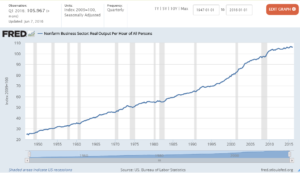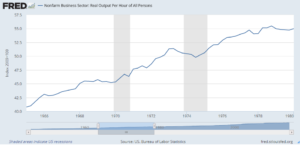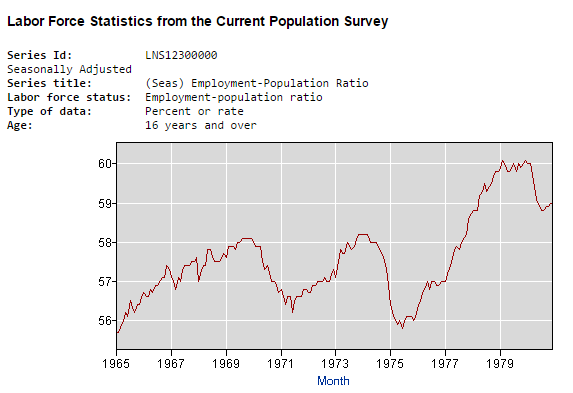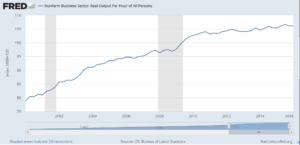The first is the % of the working age population (over 16) that is employed going back to 1948:
The second is real output per hour
As you can see the labor force size grew, albeit lumpy, over the decades. Recessions would cause drops in labor force and productivity. Then recoveries happen and employment returns and productivity continues it’s relentless march upwards.
2008 showed a different trend.
First, the drop was much steeper, which makes sense because the crisis was much larger.
Second, unlike in other recessions, the rise in productivity as the recession ends did not contribute to the workforce returning, and eventually exceeding, pre-recession levels.
Let’s compare 1965-1980 with the 2000 -2016
1965-1980
In this scenario we see a dip in labor force during recessions, followed by an increase “U” shaped productivity change and then a return to previous employment levels.
2000-2016
In the 2000 scenario both recessions see a dip in workforce, but notice there is no “U” shaped drop and there is also no return to prior levels of employment. We’re very focused on the 2008 recession because it’s more severe and more recent, but the 2000 recession had the same characteristics.
POSSIBLE REAONS
Why this is happening is hard to explain. My own opinion is that it’s related to shifts in technology and automation and NOT outsourcing labor and manufacturing.
It’s difficult to prove that of course and definition like “employment” and “productivity” are always subject to criticism. For example, the base of potential employees has shifted with an aging population on the high end and a large crop of “millennials” who have not entered the work force. That may put pressure on the 2010-2016 side especially.
There is no question that manufacturing has had a long term shift out of the US as companies try to reduce labor costs. That has also happened in many areas of Information Technology, service and other industries as well. Maybe companies figured after the recession they need to keep their costs lower so they moved jobs away or hired elsewhere.
CONCLUSIONS
In any case, I believe that the combined reality of a decreasing work force and an increasing productivity trend exacerbates the wealth distribution and polarizes politics. I think that’s why you see people like Trump and Sanders in the US, Brexit in Briton, LePen in France and so on.
I also think that despite the claims of many of these politicians, a nationally focused labor policy will not bend the curve. It’s hard for me to believe the politicians in the 1960s and 1970s were just better at managing the labor/productivity relationship or the corporate CEOs just weren’t that greedy.
It’s not all bad news though… in the salad days of the 50s and 60s, employment population rates were considerably lower than they are today. My own thought here is that this was because women were largely locked out of the labor market in most areas. An unfortunate side effect of women gaining equality is that inflation adjusted salaries can decrease as households move from one to two incomes. Still… even if the number is the same the path down is more painful to the path up. When you go from zero to a million dollars it feels very different than when you go from two million to one million.
So, I believe if you lost your job in the 2008 recession and it hasn’t come back… you might be in for a very long wait.





